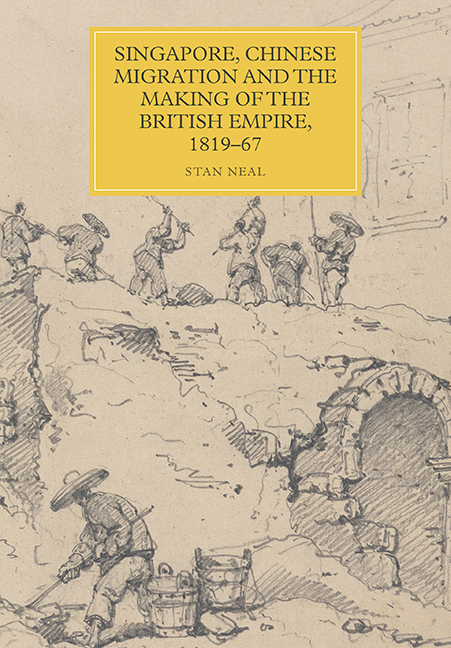Book contents
- Frontmatter
- Dedication
- Contents
- List of Illustrations
- Acknowledgements
- Language Usage
- Chronology: Singapore, the British Empire and Anglo-Chinese Relations, 1819–67
- Map
- Introduction
- Chapter 1 The Singapore Model
- Chapter 2 The Chinese Character: Race, Economics, Colonisation
- Chapter 3 Crossing the Indian Ocean: Chinese Labour in South Asia and Beyond
- Chapter 4 From Singapore to Sydney: Race, Labour and Chinese Migration to Australia
- Chapter 5 Hong Kong versus Singapore: The Dawn of Mass Migration
- Conclusion
- Bibliography
- Index
- Miscellaneous Endmatter
Chapter 1 - The Singapore Model
Published online by Cambridge University Press: 26 June 2019
- Frontmatter
- Dedication
- Contents
- List of Illustrations
- Acknowledgements
- Language Usage
- Chronology: Singapore, the British Empire and Anglo-Chinese Relations, 1819–67
- Map
- Introduction
- Chapter 1 The Singapore Model
- Chapter 2 The Chinese Character: Race, Economics, Colonisation
- Chapter 3 Crossing the Indian Ocean: Chinese Labour in South Asia and Beyond
- Chapter 4 From Singapore to Sydney: Race, Labour and Chinese Migration to Australia
- Chapter 5 Hong Kong versus Singapore: The Dawn of Mass Migration
- Conclusion
- Bibliography
- Index
- Miscellaneous Endmatter
Summary
From the start of the colonial project in Singapore, British administrators recognised the importance of the Chinese population. Stamford Raffles, who founded a trading post at Singapore in 1819, recognised the suitability of Chinese migrants from the outset:
That a speculating and industrious people like the Chinese, they must continue to operate in spite of political restrictions and partial exactions. It deserves remark that of all the inhabitants of the archipelago, the Chinese as well from their assimilating more with the customs of Europeans than the native Mahomedans, as from their habits of obedience and submission to power, are uniformly found to be the most peaceable and improvable … Borneo and the Eastern Islands may become to China what America is already to the nations of Europe. The superabundant and overflowing population of China affords an almost inexhaustible source of colonization, while the new and fertile soil of these Islands offers the means of immediate and plentiful subsistence to any numbers who may settle in them.
The ‘power’ to which Raffles believes the Chinese submit is British colonial rule. Similarly, the second Resident of Singapore, John Crawfurd, deemed that this Anglo-Chinese combination of mutual interests was so strong that he was able to refuse additional military support when negotiating the 1824 treaty that confirmed the island as a permanent British colony with indigenous leaders. Instead, Crawfurd was confident that he could draw on the support of the Chinese migrant population as a military force if negotiations turned violent. This chapter charts the racialised explanations for the role of the Chinese in Singapore's economic success, which informed subsequent strategies of colonial development. Because of Singapore's rapid growth, colonial observers saw British colonial governance and Chinese economic migration as an effective combination in the context of an empire that increasingly prioritised free trade and free labour.
Between the establishment of a trading post in 1819 and the creation of the Straits Settlements as a Crown Colony in 1867 both Singapore's population and its economic output increased significantly. Singapore became famous as an entrepôt of free trade, a lucrative trading port between India and China, but also relied on often overlooked plantation agriculture. As a site of both trade and cultivation, Singapore was a contact zone, where colonial observers developed and tested ideas about the Chinese character.
- Type
- Chapter
- Information
- Publisher: Boydell & BrewerPrint publication year: 2019



